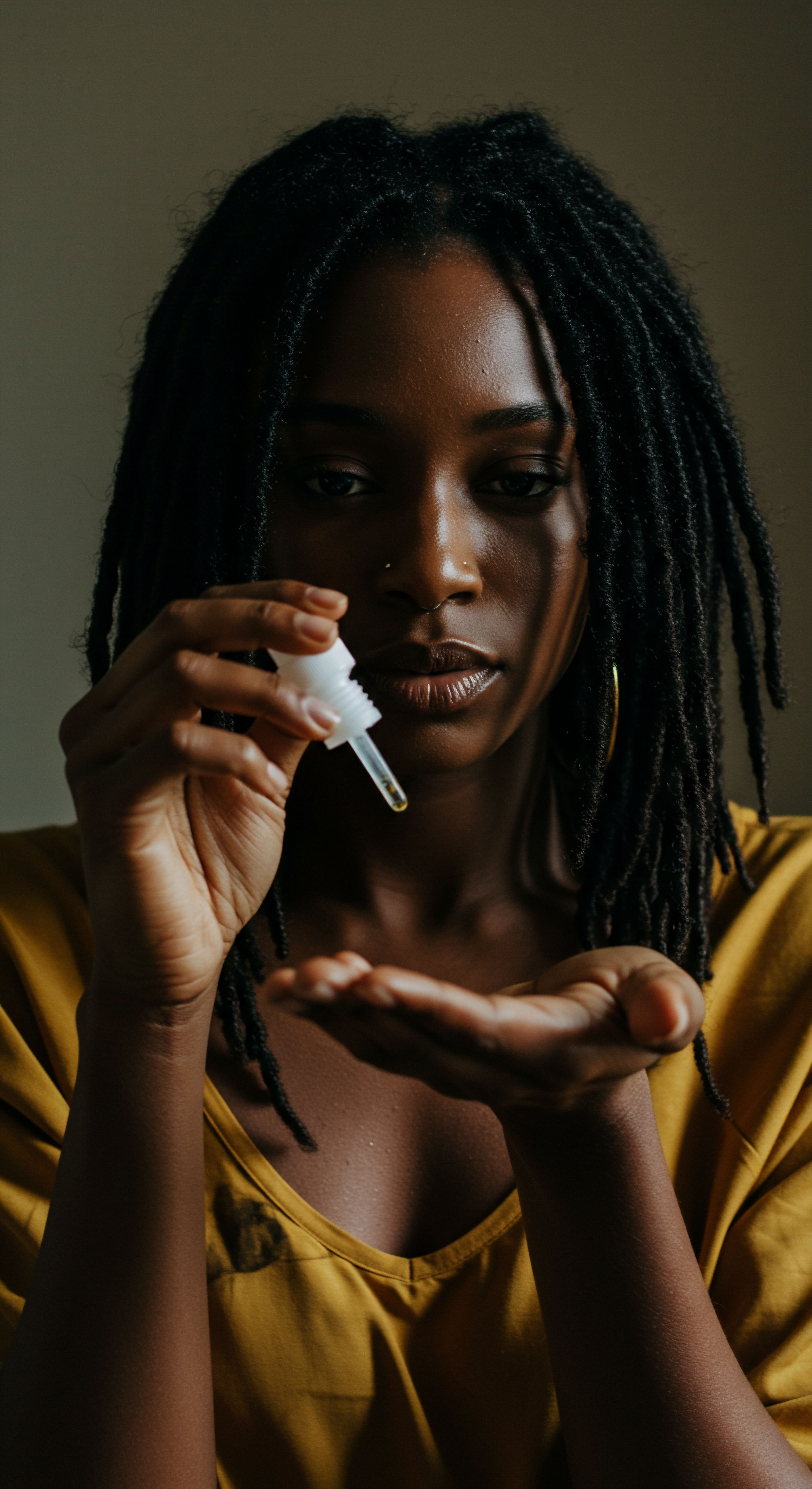
Roots
The whisper of henna, a scent both earthy and sweet, carries with it tales from forgotten ages, stories etched not onto parchment, but onto skin, hair, and nail. It is a pigment born from the sun-drenched leaves of the Lawsonia inermis plant, a humble shrub that has quietly witnessed the unfolding of human civilization for millennia. This unassuming botanical marvel, thriving in the arid expanses of North Africa, the Middle East, and South Asia, holds a history far richer than its verdant hue might suggest. Its origins are not confined to a single point on a map, but rather radiate across ancient trade routes, connecting diverse peoples through a shared appreciation for its remarkable properties.
Long before its celebrated role in adornment, henna found its earliest purpose in the realm of practical necessity. In scorching desert climates, the cooling sensation offered by a paste made from its crushed leaves provided welcome relief. Applying this natural poultice to palms and soles helped regulate body temperature, a simple yet vital comfort in environments where shade was scarce and heat relentless.
The temporary stain it imparted, a reddish-orange mark that deepened over days, was merely a fortunate byproduct, a vibrant signature left by the plant’s natural chemistry. Yet, this very signature would soon elevate henna beyond mere utility, transforming it into a powerful symbol.

What is the Earliest Recorded Use of Henna?
The earliest documented uses of henna stretch back over five millennia, with evidence surfacing in the tombs of ancient Egypt. Pharaohs and nobility, in their preparation for the afterlife, had their nails and hair adorned with henna, a practice that underscored its significance beyond fleeting beauty. This application was not simply decorative; it carried a profound spiritual weight, symbolizing purity, status, and offering a protective embrace for the journey into the next realm. The belief in henna’s ability to offer spiritual protection extended to burial rituals, serving as a conduit for honoring the departed.
Across the Indian subcontinent, henna’s presence is equally ancient, deeply interwoven with cultural expressions that predate recorded history. Its adoption was widespread, a testament to its accessibility and the intrinsic value placed upon its staining capabilities. From the banks of the Nile to the Indus Valley, communities recognized the unique interaction of lawsone, the reddish-orange dye molecule within the henna plant, with the keratin in human skin and hair. This chemical affinity created a temporary yet lasting mark, making it a natural choice for marking significant life passages and expressions of identity.
Henna’s deep roots extend far beyond mere decoration, grounding its presence in ancient practices of spiritual protection and practical cooling.

How Did Henna Spread across Ancient Civilizations?
The dissemination of henna across ancient civilizations occurred through a dynamic interplay of trade, migration, and cultural exchange. As merchants traversed vast desert landscapes and maritime routes, they carried not only goods but also customs and botanical knowledge. Henna, with its unique properties, became a valued commodity, its practical and aesthetic uses quickly recognized and adopted by new communities.
This organic spread allowed the plant and its associated practices to adapt, taking on varied styles and meanings specific to each region. For example, while ancient Egyptians used it for pharaohs’ adornment and burial rites, its path through North, East, and West Africa saw it assume different roles, often signifying wisdom and cultural pride among elders before becoming more widely used in celebrations.
The Silk Road, a network of trade routes connecting the East and West, served as a conduit for the transmission of henna art into ancient China. Here, the custom of painting red nails, originally foreign, gradually integrated with local life traditions and social aesthetics, eventually becoming a cherished part of women’s cosmetic decoration and body aesthetics in traditional Chinese culture. This illustrates how henna’s journey was not a passive reception, but an active cultural dialogue, where its meaning and application evolved with each new cultural landscape it encountered.
| Region Ancient Egypt |
| Primary Associations Purity, wealth, spiritual protection, passage to afterlife |
| Examples of Use Adorning pharaohs' nails and hair, burial rituals |
| Region Indian Subcontinent |
| Primary Associations Blessings, love, prosperity, fertility |
| Examples of Use Weddings, festivals, religious ceremonies |
| Region Middle East & North Africa |
| Primary Associations Protection against evil eye, medicinal properties |
| Examples of Use Rites of passage, skin ailments, celebrations |
| Region Berber Cultures |
| Primary Associations Sympathetic magic, personal talisman, protection |
| Examples of Use Pregnant women's bellies, life thresholds |
| Region These early uses laid the foundation for henna's enduring cultural significance across diverse societies. |

Ritual
Stepping beyond the foundational history, we encounter henna as a living, breathing ritual, a practice that transforms raw leaves into a vibrant expression of communal life and individual passage. It is in the preparation of the paste, the gathering of hands, and the meticulous application of designs that henna truly sheds its botanical origins and ascends to a plane of shared meaning. This is where the plant’s physical properties meet the human heart’s yearning for connection, celebration, and spiritual grounding.
The quiet ceremony of mixing the finely sifted powder with specific liquids – often tea, lemon juice, or essential oils – becomes a contemplative act, a prelude to the artistry that will unfold. The waiting period, allowing the lawsone dye to release its potent color, mirrors the anticipation of the significant life events it so often accompanies.
Henna application is rarely a solitary endeavor. Instead, it flourishes in social settings, fostering an atmosphere of camaraderie and intimate sharing. Women gather, their laughter and conversations mingling with the earthy scent of the paste, as designs are carefully transferred onto skin.
This collective experience reinforces bonds, transmits cultural knowledge from elder to younger, and creates a shared memory that transcends the temporary nature of the stain itself. The rhythmic flow of the cone or stick, tracing lines and dots, becomes a silent language, communicating hopes, blessings, and cultural identity.

How do Cultural Celebrations Shape Henna Designs?
Cultural celebrations profoundly shape the designs and meanings embedded within henna art. Each region, each community, possesses its own distinct aesthetic and symbolic vocabulary, transforming the application into a unique cultural statement. In the Indian subcontinent, for example, intricate patterns covering hands and feet are central to wedding rituals, particularly the Mehndi night.
These elaborate designs, often featuring peacocks, paisleys, and floral motifs, are believed to bring good fortune, love, and prosperity to the couple. The depth of the stain is frequently associated with the depth of affection between partners, a beautiful, unspoken measure of devotion.
Conversely, in many North African and Middle Eastern cultures, henna patterns might be more geometric, abstract, or symbolic, often focusing on protective motifs. The belief in henna’s power to ward off the “evil eye” is prominent here, with specific shapes and placements acting as talismans. The application during festivals like Eid or during coming-of-age ceremonies serves not only as beautification but as a ritualistic safeguard, marking individuals as blessed and shielded from harm. This regional variation underscores how the same plant can serve vastly different, yet equally profound, cultural purposes.
From intricate wedding motifs signifying love to protective symbols against ill will, henna designs serve as a visual language of cultural belief.

What is the Role of Henna in Rites of Passage?
Henna plays a central role in marking significant rites of passage across numerous cultures, acting as a visible marker of transition and transformation. These applications extend beyond mere aesthetic enhancement, signifying shifts in social status, spiritual readiness, or personal identity. For brides, particularly in South Asian, Middle Eastern, and North African traditions, the henna ceremony is a pivotal pre-wedding event.
It symbolizes the transition from girlhood to womanhood, from single life to married life, and the integration into a new family. In Yemenite Jewish communities, for instance, the bride’s henna ritual was historically the principal rite of passage for women, preparing them for their new life as a wife and separation from their original family.
Beyond weddings, henna is applied during births, particularly for expectant mothers or newborns, to offer blessings and protection. In some Nigerian cultures, the Hausa people use henna designs to adorn the hands and feet of young women during their coming-of-age ceremonies, believing these designs bring good luck and prosperity. The temporary nature of the stain itself mirrors the transient yet transformative quality of these life stages, a beautiful, impermanent record of profound change. The process often involves close female relatives and friends, solidifying communal support during these critical moments.
- Weddings ❉ Henna signifies good luck, love, and prosperity for the couple, with intricate designs often covering hands and feet.
- Births ❉ Applied to expectant mothers or newborns for blessings and protection.
- Coming of Age ❉ Marks the transition to adulthood, symbolizing readiness and new responsibilities.
- Religious Festivals ❉ Celebrated during events like Eid and Diwali, representing joy, beauty, and unity.
- Mourning Rituals ❉ In some contexts, henna can be used to signify a period of mourning or remembrance, although less common than celebratory uses.
The deliberate choice of patterns and the depth of color in these ritual applications are not arbitrary. They carry specific cultural codes, understood by those within the community. For example, certain floral patterns might represent new beginnings, while geometric shapes could symbolize strength or protection. The act of receiving henna becomes a sensory experience, grounding the individual in their cultural heritage and providing a moment of pause and reflection amidst life’s momentous shifts.

Relay
Moving from the tangible rituals, we now consider henna as a complex cultural relay, a conduit through which profound meanings are transmitted, reinterpreted, and occasionally contested across generations and geographical divides. This deep exploration extends beyond the surface beauty, inviting us to consider the less apparent complexities and the interplay of historical currents, scientific understanding, and evolving social dynamics that shape henna’s enduring presence. It is a dialogue between ancient wisdom and contemporary expression, where the plant’s inherent properties meet the shifting landscapes of human identity and belonging.
The conversation surrounding henna often overlooks its subtle yet persistent medicinal applications, overshadowed by its decorative appeal. Yet, traditional practices consistently acknowledge its therapeutic qualities. The leaves of Lawsonia Inermis have been historically applied to the hands and feet not solely for adornment, but also to protect against fungal pathogens and to combat lice and dandruff.
Other traditional uses include treatments for liver and digestive disorders, reduction of tissue loss in leprosy, and addressing diabetic foot disorders and ulcers. This dual nature—both aesthetic and therapeutic—speaks to a holistic understanding of wellbeing that characterized many ancient cultures.

What is the Sociological Impact of Henna on Identity?
The sociological impact of henna on identity is profound, extending far beyond a temporary stain on the skin. For many, henna serves as a tangible link to ancestral heritage, a visual declaration of cultural belonging in an increasingly globalized world. It acts as a powerful symbol of ethnic identity, particularly for diaspora communities seeking to maintain connections to their roots. A study by Rachel Sharaby in 2006, focusing on Yemenite Jewish women migrants in Israel, revealed an interesting phenomenon ❉ while the traditional henna ritual historically served as a rite of passage for women within the patriarchal scope of the husband’s family, its revival among younger generations in Israel became a symbol of their ethnic identity.
This shift indicates a re-centering of the ritual’s purpose, moving from solely a female passage within a specific social order to a broader affirmation of collective heritage. This highlights how rituals adapt, transforming their primary function to meet contemporary needs for cultural affirmation.
Moreover, henna can be a medium for personal expression, allowing individuals to navigate the complexities of their own identity within a cultural framework. The choice of design, the occasion for application, and the very act of adorning oneself with traditional patterns can be a conscious statement of self-definition. In a world that often homogenizes cultural expressions, the deliberate application of henna becomes an act of resilience, a quiet assertion of individuality and connection to a shared past. This personal connection often sparks a sense of comfort and familiarity, a rediscovery of positive memories tied to the practice.
Henna’s application extends beyond mere aesthetics, serving as a powerful assertion of cultural and personal identity, particularly for those in diaspora.

How do Modern Trends Interact with Traditional Henna Practices?
The interaction between modern trends and traditional henna practices presents a dynamic interplay, where ancient art forms meet contemporary sensibilities. While the core essence of henna as a celebratory and symbolic medium persists, its application and interpretation are continually evolving. The rise of social media, for instance, has transformed henna into a tool for storytelling and identity expression, reaching wider audiences and fostering new forms of artistic innovation. This digital exposure has led to a diversification of styles, with artists blending traditional motifs with modern artistic elements, and experimenting with different colors, glitter, and temporary tattoo techniques.
This contemporary adaptation, while celebrated by many as a sign of vitality and relevance, also raises questions about cultural authenticity and potential commodification. As henna gains popularity globally, there is a delicate balance to maintain between respectful appreciation and cultural appropriation. The challenge lies in ensuring that the art form’s deep cultural and spiritual meanings are understood and honored, rather than being reduced to a mere fashion accessory.
A noteworthy aspect of this modern interaction is the continued scientific exploration of henna’s properties, which often validates traditional wisdom. For example, research continues to investigate the antimicrobial and antioxidant activities of Lawsonia inermis, providing scientific backing for its historical uses in treating skin conditions and infections. Studies have shown that chloroform extracts of henna leaves exhibit antibacterial activity against pathogens like Staphylococcus Aureus and Escherichia Coli, supporting its traditional application for wound healing and skin ailments. This scientific validation reinforces the plant’s holistic value, bridging ancient empirical knowledge with modern scientific understanding.
This convergence of tradition and modernity is perhaps best observed in the way henna is incorporated into contemporary celebrations. While the core ritual remains, elements like themed parties, professional henna artists, and the integration of diverse cultural aesthetics create a syncretic experience. For example, the Turkish henna-night ceremony, traditionally a rite of passage steeped in religious symbolism, has re-emerged as a “new urban” ritual, expressing modern middle-class urban sensibilities.
This transformation involves playfully negotiating historical cultural binaries, such as religious versus secular and urban versus rural, demonstrating how consumer lifestyles can shape and redefine seemingly traditional resources. This fluidity showcases henna’s capacity to remain relevant and meaningful, adapting its form while retaining its symbolic core.
- Lawsone ❉ The primary reddish-orange dye molecule in henna, responsible for its staining properties.
- Phytochemicals ❉ Henna contains nearly 70 phenolic compounds, including naphthoquinones, linked to its pharmacological activities.
- Antimicrobial Activity ❉ Extracts from Lawsonia inermis have shown efficacy against various bacteria and fungi, validating traditional medicinal uses.
- Antioxidant Properties ❉ Henna exhibits significant antioxidant activity, contributing to its therapeutic potential.
| Aspect Primary Purpose |
| Traditional Interpretation Spiritual protection, rite of passage, medicinal aid |
| Modern Manifestation Aesthetic adornment, cultural expression, identity marker |
| Aspect Design Style |
| Traditional Interpretation Regionally specific, symbolic motifs, geometric or floral |
| Modern Manifestation Blends traditional with contemporary, minimalist designs, fusion styles |
| Aspect Social Context |
| Traditional Interpretation Intimate female gatherings, family-centric rituals |
| Modern Manifestation Public events, professional services, social media sharing |
| Aspect Medicinal Recognition |
| Traditional Interpretation Folk medicine, empirical knowledge |
| Modern Manifestation Scientific research validating traditional uses, exploring new applications |
| Aspect Henna's journey illustrates its remarkable adaptability while retaining its cultural essence. |

Reflection
As we draw our exploration to a close, the enduring presence of henna across continents and centuries speaks not only to its remarkable botanical properties but to a deeper human yearning. It is a quiet testament to the way we seek to mark our lives, to celebrate our transitions, and to adorn our bodies with meaning. Henna, in its delicate dance of pigment and skin, serves as a profound reminder that beauty is rarely superficial; it is often a language, a ritual, a connection to something larger than ourselves.
The story of henna is a continuous whisper from the past, a vibrant echo in the present, and a promising hum for the future. It stands as a living legacy, constantly reinterpreting its significance while holding firm to the wisdom of its origins. The cultural beliefs tied to henna are not static artifacts, but dynamic expressions of identity, community, and the ever-present human desire for connection and celebration.

References
- Sharaby, Rachel. “The Bride’s Henna Ritual ❉ Symbols, Meanings And Changes.” Nashim ❉ A Journal of Jewish Women’s Studies & Gender Issues, vol. 11, Spring 2006, pp. 11-42+.
- Al-Rubaye, R. et al. “Lawsonia inermis L. (henna) ❉ Ethnobotanical, phytochemical and pharmacological aspects.” ResearchGate, 2014.
- Dray, Stephanie. “The Ancient Magic of Henna Tattoos.” Stephanie Dray Official Website, 2012.
- Khan, I. “The History of Henna in Traditional Persian Medicine and Ayurveda.” THE EAST TO WEST LIFESTYLE CO, 2024.
- Humphrey-Newell, Diane M. “Henna ❉ Uses of It in the Middle East and North Africa.” Theses and Dissertations, University of North Dakota, 1999.
- St. Thomas University. “Henna ❉ Its History and Cultural Significance.” St. Thomas University, 2025.
- Ozcan, O. et al. “Consuming Ritual ❉ Reframing the Turkish Henna-Night Ceremony.” Journal of Consumer Research, vol. 37, no. 6, 2011, pp. 1029-1045.
- Obafemi, K. and Obafemi, O. “The Role of Ancient Art in Promoting Rites of Passage among Selected Ethnic Groups in Nigeria.” International Journal of Academic Multidisciplinary Research, vol. 8, no. 3, 2024, pp. 138-145.
- Semwal, R. B. et al. “Lawsonia inermis L. (henna) ❉ ethnobotanical, phytochemical and pharmacological aspects.” PubMed, 2014.
- Khan, R. A. et al. “Comprehensive Ethnopharmacological Analysis of Medicinal Plants in the UAE ❉ Lawsonia inermis, Nigella sativa, Ziziphus spina-christi, Allium cepa, Allium sativum, Cymbopogon schoenanthus, Matricaria aurea, Phoenix dactylifera, Portulaca oleracea, Reichardia tingitana, Salvadora persica, Solanum lycopersicum, Trigonella foenum-graecum, Withania somnifera, and Ziziphus lotus.” MDPI, 2024.
- Pradhan, P. et al. “Pharmacological and traditional perspectives on Lawsonia inermis ❉ a holistic approach to its multipurpose uses – a review.” Journal of Pharmacognosy and Phytochemistry, vol. 12, no. 1, 2023, pp. 102-111.
- Wang, Y. and Song, Y. “Textual Research on Henna Art Introduced into Ancient China Through the Silk Road.” Asian Social Science, vol. 16, no. 9, 2020, pp. 22-29.